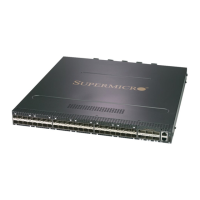Supermicro SSE-F3548S/SSE-F3548SR Configuration User’s Guide
13 Security
Supermicro switches support four methods of user authentication:
• RADIUS – Remote Authentication Dial-In User Service (RADIUS) uses AAA service for ID
verification, granting access and tracking actions of remote users.
• TACACS – Terminal Access Controller Access Control System (TACACS) provides accounting
information and administrative control for authentication and authorization. RADIUS encrypts
only password, whereas TACACS encrypts username as well, hence it is more secure.
• SSH - Secure Shell (SSH) is a protocol for secure remote connection to a device. SSH provides more
security than telnet by encryption of messages during authentication.
• SSL –Secure Socket Layer (SSL) provides server authentication, encryption and message integrity
as well as HTTP client authentication.
13.1 Login Authentication Mode
Supermicro switches allow configuration of the user login authentication mechanism.
Follow the steps below to configure Login Authentication Mechanism.
Enters the configuration mode
login authentication { local | radius | tacacs }
Configure the login authentication
mechanism to be used for switch
access.
Local – Use the local database in switch
to authenticate users.
Radius – Use RADUIS server to
authenticate users.
Tacacs – Use TACACS server to
Exits the configuration mode.
Displays the Login Authentication
mechanism.
Optional step – saves this configuration
to be part of startup configuration.
The “no login authentication” command resets the login authentication to its default of
‘local’.
The example below shows the commands used to configure Login Authentication mechanism.

